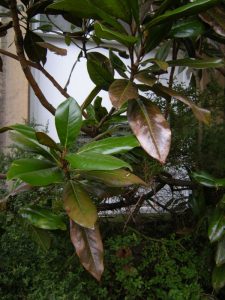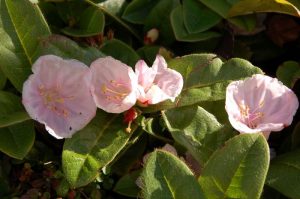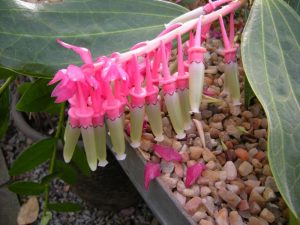After the ravages of winter and the alternating low and rising temperatures, growth is now beginning to move on plants. In the borders, damage on overwintered growth is showing as discolouration on the exposed foliage, most prominently where early morning sun has caught a frosted corner. The fast thaw of the sap within the plant tissue expanding on thawing causes cell walls to rupture, and so tissue damage occurs. This image shows frost damage on the evergreen foliage of Magnolia grandiflora – on mature plants of this size the damage is disfiguring but not fatal.
In woody plants where you suspect there may be no life, you can detect signs of life by scraping at the bark layer with a thumb nail. Where there is a sign of green colouration beneath the scraped bark, there is hope of bud burst. Never be too impatient to rip out plants.
Plants with silver / grey leaves or those with hairy leaves have experienced a bitter winter through excessive rainfall with freezing and thawing temperatures. Leaf rot on these plants will be the least of our problems this spring; basal and crown rotting will be severe. The benefit of a free-draining root zone for this group of plants is evident.
The 19th and early 20th century were the glory days of plant collecting. New plants were flooding into the country. The recipients of these highly valued specimens were not sure of their hardiness, so initially consigned them to stove houses. As knowledge of these developed, many were moved to sheltered aspects within gardens and estates. We now have a greater awareness of the hardiness of many plants and the ability to select from clones known to survive our winter conditions.
Hardiness zones were developed to help predict where a plant may reasonably be expected to survive a minimum temperature. The USDA system is well used in America, from Alaska to Hawaii. In Britain the RHS and the European Garden Flora developed two different zoning systems. However, they are only guidelines as to where in the country a plant will survive, be it outdoors or with protection.
They give a guideline as to the minimum temperature plants will experience in a set zone. Other factors will play a part in a plant’s winter hardiness: microclimate, where the plant was collected, altitude or geographical variation of type, soil (whether well drained or heavy and waterlogged) and plant association.
Thinking back to the severe winters experienced during my lifetime, the deep snow of Christmas 1962 and January 1963 was enjoyable. The snow blanketed plants in an insulating layer during the long winter of sub-zero temperatures. At the time, the container plant industry had not evolved. Plants which had proved themselves hardy in the locality were obtained as cuttings, divisions or seed from family, friends and neighbours. Nurseries sold plants bare-root, with autumn as the preferred season for planting.
The winters of 1978 – 79 and 1981 – 82 also highlighted the benefit of good plant selection. By this time, containerisation and the garden centre industry were well developed. With a ready supply of container plants, the planting season extended the year through, with spring most popular. Many southern hemisphere plants succumbed during these two winters… and will again due to this winter’s harsh weather. We can hope for a traditional spring of sunshine and showers with no late frosts to boost plants into life and encourage growth.
Two select members of the Ericaceae family that we continue to provide protection for are presenting flowers now.
Epigaea gaultherioides is native to temperate South-West Asia. This shallow-rooting member of Ericaceae is found colonising the corner of a shaded north-facing frame adjacent to the Alpine House, where it appreciates a well-drained, cool root run. To flower successfully, it needs protection from the severe cold of the winter, but ironically must experience a cold spell to initiate flowering.
From Equatorial Ecuador at 2000+ metres we grow Cavendishia grandiflora. Collected on the old road from Quito Santo Domigo in the Pichincha province, the terminal flowers hang down, reminiscent of a scene in a dairy farm milking parlour. It is potted in an open bark mix, growing in the back-up glasshouses where the night minimum temperature is 10°C or above.



